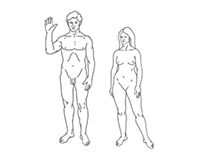Dating sims (or dating simulations) are a video game subgenre, usually Japanese, with romantic elements. They are also sometimes put under the category of ‘neoromance.’ The most common objective of dating sims is to date, usually choosing from among several characters, and to achieve a romantic relationship. They can involve several technical elements such as a time limit, several statistics such as looks and charm which can be boosted through exercise, or an ‘attraction meter’ which can increase or decrease depending on one’s decisions.
The term dating sim is also often used incorrectly as a synonym for the visual novel genre. While the two genres often share a common visual presentation, dating sims are sometimes considered to be more statistically based than the ‘choose your own adventure’ style of visual novels.
In a typical dating sim, the player controls a male avatar surrounded by female characters. The gameplay involves conversing with a selection of girls, attempting to increase their internal ‘love meter’ through correct choices of dialogue. The game lasts for a fixed period of game time, such as one month or three years. When the game ends, the player either loses the game if he failed to properly win over any of the girls, or ‘finishes’ one of the girls, often by having sex with her, marrying her, and/or achieving eternal love. This gives the games more replay value, since the player can focus on a different girl each time, trying to get a different ending.
Dating sims often revolve almost entirely around relationship-building, usually featuring complex character interactions and branching dialogue trees, and often presenting the player’s possible responses word-for-word as the player character would say them. They often give choices that have a different number of associated ‘mood points’ which influence a player character’s relationship and future conversations with a non-player character. These games often feature a day-night cycle with a time scheduling system that provides context and relevance to character interactions, allowing players to choose when and if to interact with certain characters, which in turn influences their responses during later conversations.
A bishōjo game (‘pretty girl game’ or ‘gal game’) is a type of dating sim centered on interactions with attractive anime-style girls. These games are targeted towards a male audience, and are a uniquely Japanese phenomenon: they have virtually no equivalent in the western video game industries. They form a sizeable fraction of the Japanese market and make up the majority of offline PC games in Japan. Because of cultural differences, only a few titles have been translated or commercialized outside of East Asia.
While bishōjo games make up the bulk of dating sims, other types of games exist. Games where the player character is female and potential objects of affection are male are known as ‘GxB’ or ‘otome games.’ Homosexual relationships are also possible, as there are games with no specific gender lines (‘all pairings’). There are also GL (Girl’s Love) games, which focus on female/female relationships, and BL (Boy’s Love) Games (also called ‘yaoi’), which focus on male/male pairings.
There are many variations of dating simulator’s, but high-school romances are the most common. Fantasy settings are also popular and involve such challenges as defending one’s girl from monsters.
One game series that often includes dating, with the goal of marriage, is the farming sim series ‘Harvest Moon.’ The subplot of dating is more focused towards choosing one of several girls or guys (dependent on the player character’s gender) and offering them presents or joining them on events in the game.
Some Eastern Asian dating sims may allow the player to have romantic or sexual relationships with characters in their teens. The degree of sexual content varies, but may often include intercourse. Sexually explicit dating sims may fall into the category ‘eroge’: a portmanteau of ‘erotic game’ featuring erotic/ pornographic content, usually in the form of anime-style artwork. Eroge companies usually make a censored all-ages(15+) version of their games. The censored version contains far more endings and new added scenes due to the absence of sexual scenes.
The Daily Omnivore
Everything is Interesting



Leave a comment